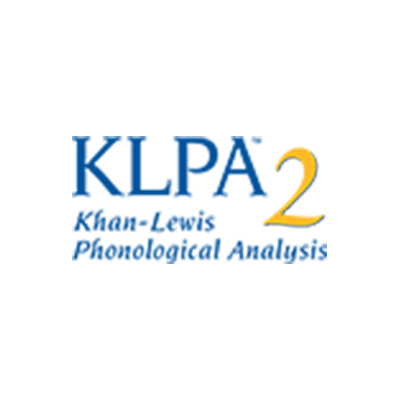Linda Khan, ML MS, CCC-SLP, Nancy P. Lewis, MS, CCC-SLP
Age Range:2:0 - 21:11
RTI Tiers:RTI Levels 2 and 3
Completion Time:10-30 minutes
Scores/Interpretation:0 Developmental Phonological Processes yield standard scores, percentiles, test-age equivalents, and percent-of-occurrence for individual processes by age.
Comprehensive diagnosis
Now you can make a greater impact on students with speech disorders with the newest edition of the Khan-Lewis Phonological Analysis (KLPA-2). It works with Goldman-Fristoe 2 to give you a more comprehensive diagnosis of both articulation and use of phonological processes. That means you can make more informed therapy decisions.
Discover these new features in KLPA-2:
- Expanded scoring
- Greater age range: 2 through 21
- Streamlined, easier-to-use Analysis Form
- New supplementary materials: an all-inclusive Sound Change Booklet, and Goldman-Fristoe 2 Phonological Summary and Progress Report for parents that complies with Goldman-Fristoe 2 IDEA.
Fast, efficient—and accurate!
First you administer Goldman-Fristoe 2 to get a detailed measure of articulation ability. Then you transfer the responses to the KLPA-2 Analysis Form. Next, use the Sound Change Booklet to identify which phonological processes were used. Easy to read and color-coded, the booklet gives you diagnostic phonological information at a glance. And KLPA-2 scoring takes only 10-30 minutes, compared with up to two hours for similar analyses.
Finally, use the new Phonological Summary and Progress Report for parents to develop targeted treatment strategies. Fully compliant with IDEA, the report allows you to record remediation goals and objectives for many common phonological disorders such as Initial Voicing and Liquid Simplification.
Increase efficiency with computer scoring and reporting
 The ASSIST software program helps you score, calculate, and compare normative data for both Goldman-Fristoe 2 and KLPA-2 tests. At the touch of a button you can print out separate score summaries for the Goldman-Fristoe 2 and KLPA-2. Or print out a combined report for detailed diagnostic information. Reports are easy to customize by test section and diagnostic topic; a Recommendations section even has summary text. You also can set a local criterion to obtain developmental norms comparisons from the biggest and best standardization sample to date!
The ASSIST software program helps you score, calculate, and compare normative data for both Goldman-Fristoe 2 and KLPA-2 tests. At the touch of a button you can print out separate score summaries for the Goldman-Fristoe 2 and KLPA-2. Or print out a combined report for detailed diagnostic information. Reports are easy to customize by test section and diagnostic topic; a Recommendations section even has summary text. You also can set a local criterion to obtain developmental norms comparisons from the biggest and best standardization sample to date!
A winning combination
Get complete and up-to-date tools for diagnosing articulation and phonological processes. Save when you order KLPA-2 and Goldman-Fristoe 2 together.
Features & Benefits
Provides guidelines for remediation planning
Easy to read Sound Change Booklet gives you information at a glance
Works with Goldman-Fristoe 2 for a more detailed diagnosis of speech
Questions
Frequently asked questions follow. Click on a question to see the response.
Test Content
-
Why are words such as duck, yellow, and flowers which have phonetic contexts easily influencing assimilation errors still used?
-
Why is there no inclusion of vowel production as in the Arizona Test of Articulation?
-
Has a study been done that looks at which format is “better” pictures vs. photographs?
-
Are there plans to update the GFTA-KLPA-2 normative data?
-
When you anticipate production of a new edition?
-
It would be great if the test tested for post vocalic “r.”
-
Will there ever be a normed intelligibility section?
-
Do you anticipate a Spanish version in the near future?
-
Will there be an iPad application?
Administration
-
If a student has met all of his goals and objectives and is ready to exit speech therapy…is it necessary to give him the full assessment of the Goldman-Fristoe-2?
Scoring
-
If a child’s production of a sound is perceptually accurate, but the placement is incorrect (i.e. interdentalization of /t, d, n/, how would that be scored?
-
If a child does not have an /s/ in his or her repertoire, marking all the /s/ blends as incorrect seems to skew the score somewhat. Have I been scoring this correctly?
-
The target sound in the picture balloons is the medial /l/. However, if the child has difficulty producing the /s/ sound, do you count that error when finding the raw score or only the target sound for each picture?
-
The raw score is determined from the Sounds in Words section of the test. If a child scored 0 for their raw score but had 6 errors on Sounds in Sentences–could those errors be counted for a ‘raw score’?
-
How do recommend interpreting scores for a child around age 2 ½ who is administered the test but responds to very few pictures, even in imitation. His non-responses are not counted as errors, so his score is inflated.
-
I’m still not sure how to use the Supplemental Developmental Norms to interpret child’s performance.
-
In reference to the normative table for sound development, what is the exact chronological age for which the sample correctly produced the sounds? For example /b/ in initial position words, is it delayed at two years, zero months?
-
Table 2.1 states age at which 85% participants accurately produced by age. You indicated that there was a chart available for medial and final. Can you give the table and/or reference for that?





